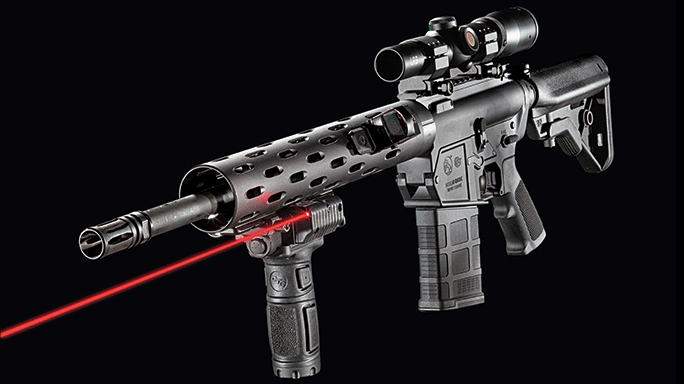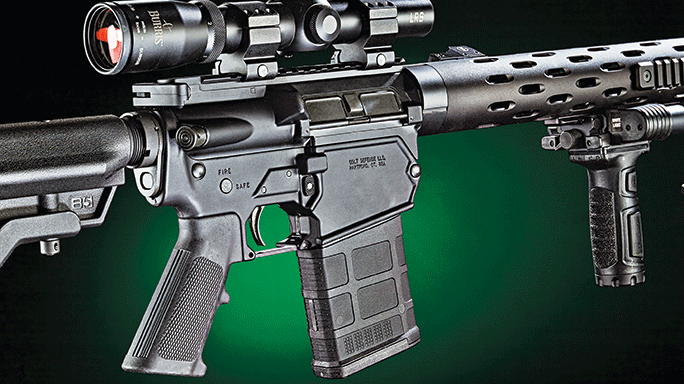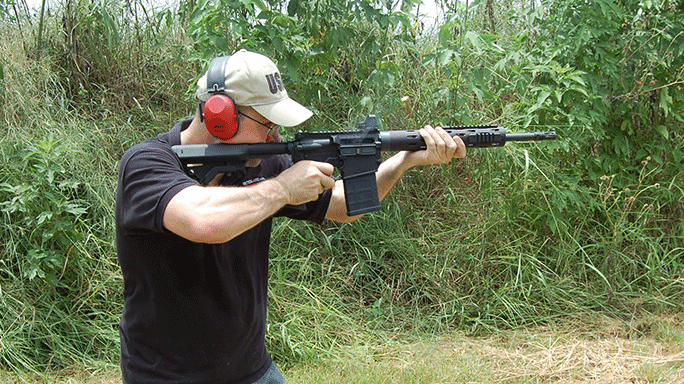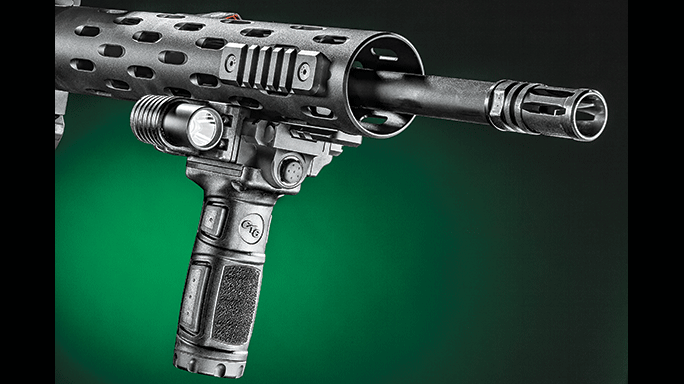Modularity in firearms design—the ability to exchange and combine system components and accessories—has increased greatly and is becoming more necessary. Mission and shooting requirements change, so it is useful to have systems that can easily adapt as needed. In keeping with this progress, Colt recently introduced its M.A.R.C. (Modular AR Carbine) 901 line. And it is truly modular. While Picatinny rails, for example, make it easy to swap out accessories, Colt has expanded upon this concept by adding configurable handguards (the rails themselves can be moved or removed).
- RELATED STORY: Gun Test: Colt’s M.A.R.C. 901 Series of AR Carbines
But the biggest feat of the M.A.R.C.901 series is that they’re multi-caliber rifles. They feature receiver groups that can easily be swapped out with other upper receivers in different chamberings. The lower receiver and bolt carrier design enable the upper receiver group to be swapped without tools beyond a simple adapter in the same time it takes for routine disassembly. In short, the .308 Winchester/7.62mm NATO base rifle can be switched to a standard 5.56mm NATO upper receiver with a simple conversion kit. This capability exceeds the requirements of the Special Operations Forces Combat Assault Rifle program established by U.S. Special Operations Command (USSOCOM) by providing a modular, multi-
caliber weapon system with a single serial number.
M.A.R.C. Particulars
Advertisement — Continue Reading Below
There are currently two M.A.R.C.901 rifles available. The LE901-16S features a 16.1-inch barrel, a monolithic upper receiver with a user-configurable forend and multiple push-button sling attachment points. It comes with flip-up sights, ambidextrous controls, a bayonet lug and a four-prong flash suppressor. Its MSRP is $1,999.
I recently got my hands on the AR901-16S, which is more of an entry-level model. Rather than a large monolithic upper receiver with a Picatinny rail extending the entire length of the handguard and receiver, the AR901-16S uses a lighter, more traditional flattop upper with a tubular handguard. This removes little in the way of functionality, as the upper still sports a rail and the free-floating handguard includes rails at the 3, 9 and 12 o’clock positions. These accessory rails are user configurable and can be exchanged, moved to any of the dozens of slots surrounding the handguard or removed entirely.
Other differences include an A2-style birdcage flash suppressor instead of the four-prong unit on the LE901-16S; a B5 Systems SOPMOD Bravo stock; standard, non-ambidextrous controls; and no backup sights are included. My test AR901-16S also came with a 20-round Magpul PMAG, an Accu-Wedge, a cable lock and an instruction manual.
Advertisement — Continue Reading Below
Switch Hitter
The AR901-16S disassembles like every AR-15 rifle you’ve ever used. The bolt and front half of the bolt carrier have the same dimensions as 7.62mm AR rifles, however, the rear half of the carrier tapers down to the same diameter as a typical 5.56mm bolt carrier. This allows the lower receiver to use both 5.56mm and 7.62mm uppers. The AR901-16S’ buffer tube keeps the smaller rearmost dimensions of the carrier stable, preventing any tilting and offering solid reliability.
Converting the AR901-16S lower to take a standard-sized AR-15 upper requires a separately sold adapter that does two things. First, the adapter fills in the magazine well, narrowing and shortening the internal space to the same dimensions as a 5.56mm magazine. Second, the adapter contains a flush, self-captive pin that attaches it to the front takedown pin hole on any standard-size AR-15 upper along with the front takedown pin on the AR901-16S lower. Once the adapter is in place, mounting a standard AR-15 upper is no more difficult than taking down a standard lower. Once the captive pin is set, it will remain secured inside the AR901-16S magazine well—it won’t loosen or fall out. Also, this adapter serves as a solid mounting block and allows the 5.56mm upper to function normally, unlike 9mm adapters, for example, which require receiver modifications.
Advertisement — Continue Reading Below
It is worth noting that many AR-15 caliber conversions can require different springs and/or buffer weights, and the AR901-16S is no different. The AR901-16S’ buffer tube has the same dimensions as a standard AR-15’s, so this is a simple parts swap. To avoid a mix-up, the buffer in the AR901-16S is marked “308.” Colt’s approach is non-proprietary and fits any standard upper made by any company.
The conversion kits that allow both of Colt’s versatile M.A.R.C.901 rifles to use 5.56mm uppers are sold separately and include a buffer, buffer spring and magazine well adapter. These are available directly from Colt for $199.
Colt partnered with Magpul and designed its M.A.R.C.901 rifles around Magpul’s popular PMAGs. Like other Magpul magazines, the included 20-rounder is durable and reasonably light. And you can get plenty of spares for about $20. The adapter includes a spacer for the magazine well and, in 5.56mm guise, the AR901-16S accepts all standard AR-15 magazines, including aluminum GI units, those from Magpul and HK’s heavy-duty steel units.
Advertisement — Continue Reading Below
Shooting Impressions
M.A.R.C.901 rifles have 1-in-12-inch-twist barrels—a bit slower than the more typical 1-in-10-inch twist rate found in many .308s. However, this is more than enough for the 150-grain weight range typical with military ball ammo and still fast enough for bullets up to 175 or so grains. Many match and police loadings are in the 168-grain range. For most practical uses, many shooters aren’t going use anything heavier than 175 grains out of a .308. Bigger bullets still have to be seated deep enough to feed out of the magazine (unless you’re going to single load each shot) and this will take up more powder space, taking the already reduced velocity potential down further. I suspect many M.A.R.C.901 shooters will stick to M80 ball ammo or a commercial or handloaded equivalent. Shooters with access to military supplies may likely feed it M118LR ammo regularly. Keeping with this, I opted to test the AR901-16S with bullets weighing 168, 173 and 175 grains. If it will handle these well, it will certainly stabilize lighter bullets sufficiently. I used two 168-grain loadings: HPR’s boat-tail hollow points (BTHPs) and Federal’s Gold Medal Match Sierra MatchKing BTHPs. I also used 173-grain M118 FMJs from Lake City and 175-grain M118LR rounds.
For group shooting, I mounted my SWFA SS 10×42 Tactical 30mm Classic scope and used Thompson Target Bright Lightning bullseye targets. I generally prefer round marks for group shooting, as a round bullseye is always right side up, and the Thompson targets are highly visible, making it easy to discern impacts with any optic, even the riflescope.
Advertisement — Continue Reading Below
After settling behind the AR901-16S, I printed a half-inch three-shot group at 50 yards—1 MOA—while I was still zeroing and breaking it in. Next, I set up for 100-yard testing. The AR901-16S’ accuracy was pretty good for a lightweight, self-loading .308 carbine, and it shot under 2 MOA with all of the test ammunition. The HPR ammo gave the best group of the day at just under 1 MOA and was consistently under 1.25 inches across at 100 yards. Not surprisingly, the Federal Gold Medal Match did about as well and proved a bit more consistent. Both of these loads are known to be high-quality, match-grade performers.
The military-issued loads also fared well. The M118LR averaged group sizes of 1.5 inches, and the 173-grain load averaged 1.7 inches. Even the worst group of the day was just under 2 inches. It could be argued that a 1-in-10-inch twist rate might help the heavier bullets, although this difference could just as likely be due to the commercial match ammunition simply being better quality cartridges. For anyone who understands field marksmanship, these groups demonstrate that this quick-handling carbine is a consistent performer and an honest sub-2-MOA carbine that might be tweakable to almost 1 MOA with careful ammunition selection.
Colt Thoroughbred
Advertisement — Continue Reading Below
While its accuracy is quite good, especially for a fairly lightweight .308 Winchester/7.62mm NATO AR, the AR901-16S really shines in terms of handling. I exchanged the SWFA scope for a Meopta MeoSight III, zeroed it dead-on at 50 yards and ran some timed, off-hand singles.
Competitive shooters were the first serious users of red-dot sights, beginning with precision pistol disciplines like Bullseye and Bianchi Cup matches in the 1980s, and speed shooters in the 1990s. As competitors figured out their advantages and manufacturers increased their reliability, durability and battery life, these “rooney gun” competition accessories became common in the shooting world. Further technology advancements, first tested extensively in IPSC’s Open division, miniaturized these units down to pistol-compatible sizes. Despite the small size, top-notch micro reflex sights such as the MeoSight III work great on long guns as well. Having a tubeless, instant heads-up display makes the MeoSight one of the fastest sighting systems available.
Despite chambering and launching bullets three times as heavy as a 5.56mm, the AR901-16S carbine handled just as quickly as its smaller-caliber brethren. Off-hand singles from low-ready in under one second came just as readily as 5.56mm AR-15s, and the barely noticeable increased weight neatly soaked up any difference in felt recoil.
Advertisement — Continue Reading Below
- RELATED STORY: Sneak Peek: Hands On Colt’s New M.A.R.C.901 Series
The Colt AR901-16S carbine shines when it comes to fast, accurate shooting, and if you add in its 5.56mm/7.62mm compatibility, it’s an extremely versatile performer.
For more information on the AR901-16S, visit colt.com or call 800-962-2658.
Specifications
Advertisement — Continue Reading Below
- CALIBER: 7.62mm NATO
- BARREL: 16.1 inches
- OA LENGTH: 34.24-37.5 inches
- WEIGHT: 8.4 pounds (empty)
- STOCK: B5 Systems SOPMOD Bravo
- SIGHTS: None
- ACTION: Direct impingement semi-auto
- FINISH: Matte black
- CAPACITY: 20+1
- MSRP: $1,399


























